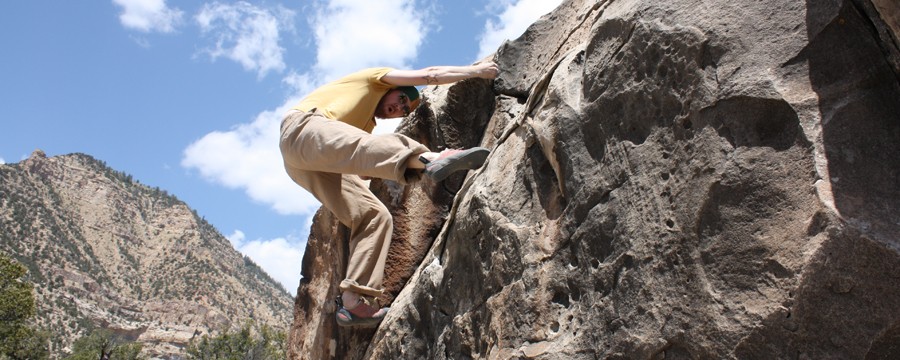Part 1: You’re not hardcore unless you live hardcore: The Quest for 5.13a, E7, 7c+ or 9b
Rock climbing is a physically and mentally demanding sport. It will test your strength, endurance, agility, and balance along with your mental control. In rock climbing, climbs have grades that describe the difficulty and danger that you can expect with a climb. The grading system factors several qualities including the technical demand of the moves, strength and stamina required, the level of committment (mental control) required and the difficulty of protection. Anything that is considered rock climbing requires the use of a 3 point stance (Two hands and a foot or two feet and a hand) on the rock, and it begins at level 5.0. This is called the Yosemite Decimal System.
YOSEMITE DECIMAL SYSTEM:
Generally speaking, anyone who is somewhat physically capable can climb grades between 5.0 and 5.6 pretty easily. It doesn’t matter how old or young you are, if you are physically active even to the smallest extent, you can make it up a climb at any of these levels. As the grade goes up from there, however, the climbs get significantly more difficult per grade. They become steeper with smaller holds for your hands and feet, and require more technical movements to get yourself up the wall. Most active humans can climb 5.7 through 5.9 without much experience, and feel comfortable at those grades. Once you get into the 5.10 grade and above, the climbs are broken out into sub-grades: a, b, c, d. The difference between each of the sub-grades is VERY noticeable. A 5.10b climb is exponentially easier than a 5.10c climb, and so on. This range is generally where the weekend climber and the dedicated climber start to truly differentiate. After the 5.10 range, you are pretty much in the dedicated climbing world, and you need to build up strength, endurance, flexibility and mental control to progress beyond.
Mental control is paramount in rock climbing. Fear has the ability to convince you that you “can’t” do something. It can and will hold you back from success in climbing, and as climbs get harder and harder, the fear-factor goes up with them. Because, who are we kidding…this is some scary Sh#$. Building mental control takes a lot of practice and time. When you can control your mind, you can overcome your fear and push through boundaries to higher levels of climbing. And that is truly what makes rock climbing such an addiction…when you break through to the next level with your mind and body. Nothing is more rewarding!
World Class Climbing is considered anything 5.12 and above. The 5.12 range requires pretty much optimal level of everything (balance, control, strength, endurance, technique). A climb at this grade has only been achieved by about 10% of the climbing population, and the numbers drop off exponentially as the grades go up even just a little bit. I am currently operating at about the 5.12a-c range in my ability. I have been climbing for 15 years, and it has taken me A LONG TIME to get here. I am ready to commit to get to the next level.
I tell you that, because I want you to understand what it means to be a 5.13 climber. This post is certainly not meant to be a “How to climb a 5.13” explanation, because that would require an entire book. But I do want you to get a sense of what I’m talking about so that you can understand why this level is such a huge feat (especially if you are a non-climber).
I won’t bore you with the details of how we got to this point, because that would require a LONG explanation. Years and years of time, travel, and climbing. Together, Jilly and I have climbed all over the US. We moved to Boulder, CO almost a decade ago, for the sole purpose of climbing. We have trained seriously for years…and years…This blog series will be a journey into what it takes to climb at the next “unreal” level, 5.13. Hopefully there will be a happy ending before winter frost sets in.
We have already started training…and both of us have our own goals. Mine is to accomplish my first successful 5.13 climb on lead — no falls, no takes. Jill’s is to accomplish her hardest lead climb, which is a 5.11d — no falls, no takes. She has climbed several 5.12’s, but not on lead. It’s not common AT ALL for females to reach this level in climbing. The main reason we pretty much only climb together is because very few men can keep up with me, but the wifey does just fine.
Lead climbing is a climbing technique used to ascend a route. This involves a lead climber attaching themselves to a length of climbing rope and ascending a route, while periodically attaching protection to the face of the route, and clipping the rope into it. Protective devices are only placed to catch the climber in the event of a fall. At any point, the leader can fall at least twice as far as the distance to the most recently placed protection. If a leader is ten feet above the last piece of protection, a fall will be a minimum of twenty feet. Generally a fall is unexpected, but can and does happen frequently.
A take is when the climber needs a break. The belayer takes up all the slack in the rope so that the climber can stop climbing, and rest right where they are. So when we say no falls or takes, it means that we will succesfully climb the entire route from the bottom to the top, without any breaks: falls or rest.
THE PLAN OF ATTACK
Over years of training we’ve learned to make our workout schedules pretty flexible so that we can still prentend to have real lives. In an average week, we spend about 12-15 hours-per-week training. We will amp that up to 17-20 hours per week for this achievment; pretty much a part-time job. The break-out of our time will be about dedicated as such: 65% climbing and 35% conditioning (conditioning is anything that is not actual climbing).
While we do have a preliminary ‘schedule’ we try to keep it flexible: Ride 75 miles per week, climb 3 times a week (one of which has to be outside but two days outside will be the goal). Take one or two yoga classes per week for injury prevention, mental relief & flexibilty. Do endurance/crossfit and core-work, and that is the jist of our schedule. Most climbing workouts will include hard climbing, drills on climbing system boards, weights, and cardio. So there you have it, lets get to it!
SCHEDULE
Sunday: Optional Rest Day, if feeling good hit up a yoga class
Monday: Active Recovery Day, Bike ~25 miles, do a hard alignment yoga
Tuesday: Climbing Day, outside or inside either way climb hard, maybe bike
Wednesday: Active Recovery day Bike ~25 miles, do an easier yoga class
Thursday: Climbing Day, outside or inside either way climb hard, maybe bike
Friday: Optional Rest Day, if feeling good hit up a yoga class
Saturday: Super hard workout: Cardio, hard bouldering, crossfit/curcuit training, core work












